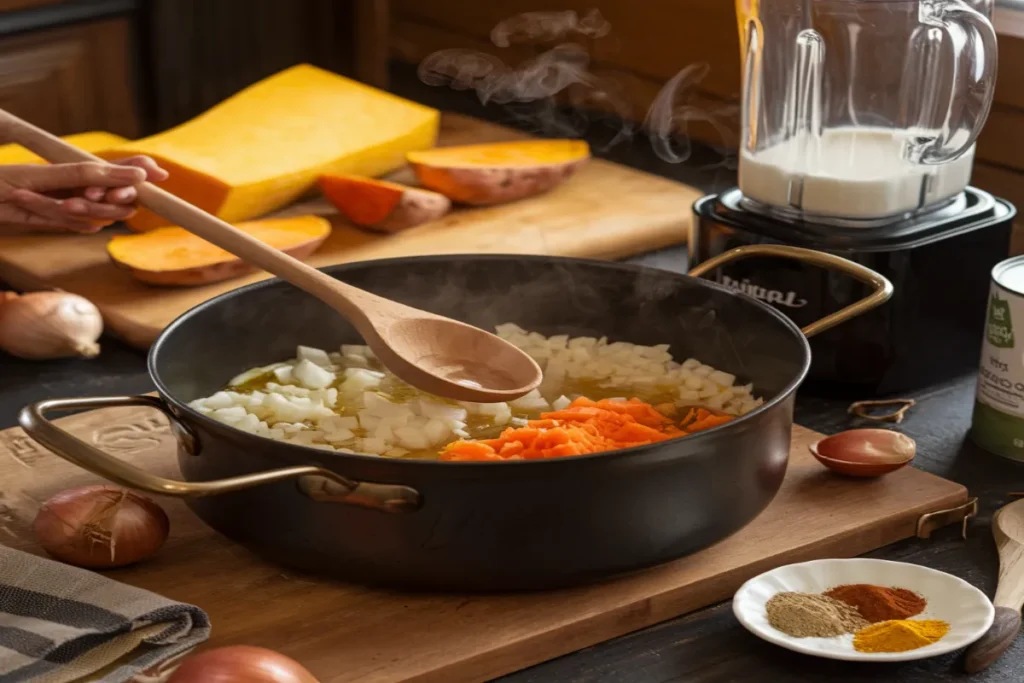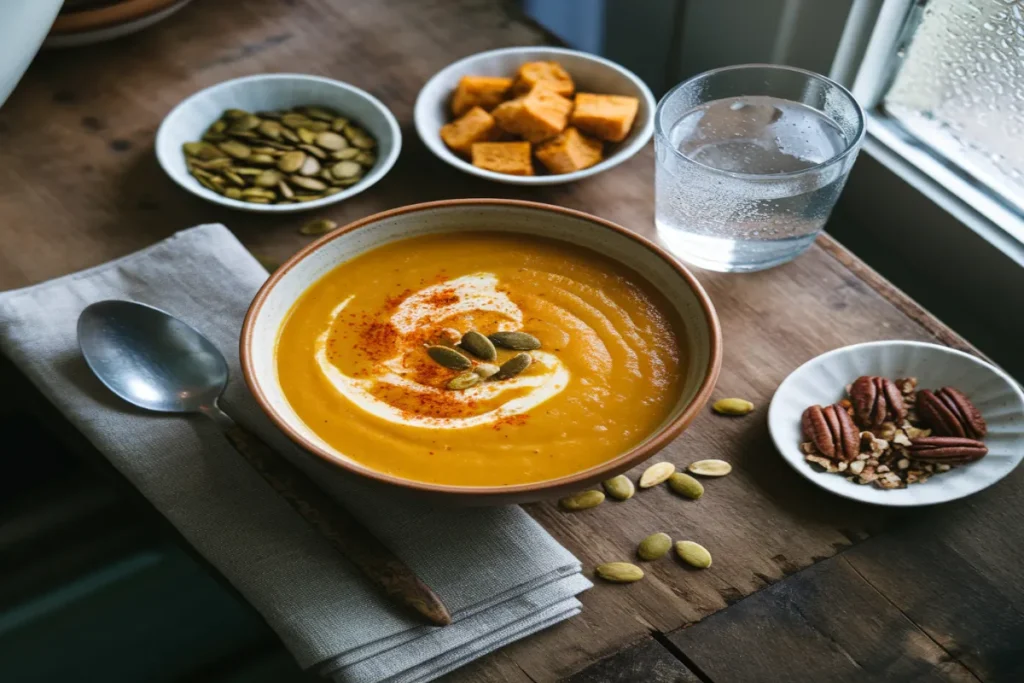There’s something truly comforting about a bowl of warm, creamy soup on a chilly evening. I remember the first time I made this butternut squash sweet potato soup—it was a dreary autumn day, and I wanted something to lift my spirits. The aroma of roasting vegetables filled my kitchen, and by the time I blended everything together, I knew I’d found a keeper.
This recipe has been a staple in my home since 2013, evolving slightly over the years but always delivering that perfect balance of savoury and sweet. The combination of onion, garlic, ginger, and warming spices creates a depth of flavour that’s hard to resist. And let’s not forget the creamy texture from coconut milk—it’s pure comfort in every spoonful.
Whether you’re curled up in your slippers or hosting friends, this soup is a crowd-pleaser. It’s easy to make, packed with wholesome ingredients, and perfect for any occasion. Stick around for the full recipe—I’ll guide you through every step to ensure it turns out just right.
Table of Contents
Getting Started: Ingredient Preparation and Recipe Planning
The key to a delicious dish lies in the quality of its ingredients. For this soup recipe, selecting fresh, vibrant vegetables is essential. Proper preparation ensures a smooth, creamy texture and rich flavour. Let’s dive into how to choose and prep your ingredients like a pro.
Selecting the Best Butternut Squash and Sweet Potato
When shopping, look for firm, unblemished butternut squash with a matte finish. A ripe one feels heavy for its size. For sweet potatoes, choose ones with smooth skin and no soft spots. These signs guarantee freshness and maximum flavour.
Prepping Vegetables: Peeling, Chopping and Dicing Tips
Start by peeling the butternut squash and sweet potatoes with a sharp peeler. Cut them into uniform cubes for even cooking. A sturdy knife and a steady hand make this step quick and safe. Properly chopped vegetables release their natural sweetness, enhancing the soup’s taste.
Essential Kitchen Tools and Techniques
Having the right tools in your kitchen can transform your cooking experience. Whether you’re a seasoned chef or a beginner, the right equipment makes all the difference. Let’s explore the essentials that will help you create a perfect dish every time.
Choosing the Right Pot and Blender
A heavy-bottomed pot is a must for even cooking. It distributes heat evenly, preventing burning and ensuring your vegetables cook perfectly. Look for one with a sturdy handle and a tight-fitting lid.
For blending, a high-powered blender is key. It creates a silky smooth texture, turning your ingredients into a luxurious dish. A reliable blender saves time and effort, making it a worthwhile investment.
Mastering the Art of Roasting and Sautéing
Roasting brings out the natural sugars in vegetables, enhancing their flavour. Preheat your oven and spread the vegetables evenly on a tray for the best results. This step adds depth to your dish.
Sautéing onions and garlic in a bit of oil creates a savoury base. Stir frequently to prevent sticking and ensure even cooking. These techniques are simple but elevate the taste of your recipe.
| Tool | Benefit |
|---|---|
| Heavy-Bottomed Pot | Ensures even heat distribution |
| High-Powered Blender | Creates a smooth, creamy texture |
| Oven Tray | Perfect for roasting vegetables |
| Sharp Knife | Makes chopping quick and safe |
Investing in quality tools enhances both the taste and presentation of your dish. With a bit of practice, these techniques will become second nature. Happy cooking!
Step-by-Step Instructions for butternut squash sweet potato soup
Crafting a comforting bowl of soup starts with building layers of flavour. This recipe is all about simplicity and technique, ensuring you achieve a rich, creamy texture every time. Let’s break it down into two key stages: creating a savoury aromatic base and blending for that silky finish.
Building a Savoury Aromatic Base
Begin by heating a tablespoon of olive oil in a heavy-bottomed pot over medium heat. Add finely chopped onion, two minced garlic cloves, and a grated carrot. Sauté for about 5 minutes until the vegetables soften and release their aroma.
Next, stir in half a teaspoon each of ground coriander, cumin, and ginger. These spices add depth and warmth to the base. Cook for another minute to let the flavours meld. This step is crucial for creating a foundation that’s both fragrant and flavourful.
Achieving a Silky Smooth Texture Through Blending
Once your base is ready, add the roasted butternut squash and sweet potato cubes to the pot. Pour in 500ml of vegetable stock and bring the mixture to a gentle simmer. Let it cook for 15-20 minutes until the vegetables are fork-tender.
Allow the mixture to cool slightly before transferring it to a high-powered blender. Add 100ml of coconut milk for creaminess. Blend until smooth and velvety. If needed, adjust the consistency with a bit more stock or milk.
| Step | Key Tip |
|---|---|
| Sauté Aromatics | Cook until fragrant for maximum flavour |
| Add Spices | Toast briefly to enhance their aroma |
| Simmer Vegetables | Cook until tender for easy blending |
| Blend with Coconut Milk | Cool slightly for safety and smoother results |
Follow these steps, and you’ll transform simple ingredients into a restaurant-quality dish. The result? A bowl of soup that’s as nourishing as it is delicious.

Enhancing Flavour: Spices, Coconut Milk and More
A pinch of spice and a splash of cream can transform a simple recipe into something extraordinary. In this section, we’ll explore how to elevate your dish with warm spices, herbs, and the creamy richness of coconut milk. These elements work together to create a depth of flavour that’s both comforting and complex.
Incorporating Warm Spices and Herbs
Spices like curry powder, cumin, and nutmeg add warmth and complexity to your dish. Start by toasting them briefly in a pot to release their aroma. This simple step intensifies their flavour, making every spoonful more satisfying.
Add spices gradually, tasting as you go. This allows you to build layers of flavour without overwhelming the dish. A pinch of cayenne pepper can add a subtle kick, while thyme brings an earthy note. Balance is key—each spice should complement, not dominate.
Using Coconut Milk for Creamy Richness
Coconut milk is the secret to achieving a velvety texture. Its natural creaminess balances the sweetness of the vegetables, creating a harmonious blend. Use full-fat coconut milk for the best results—it’s richer and more indulgent.
If you’re looking for alternatives, cashew cream or oat milk can work well. These options maintain the creamy consistency while catering to dietary preferences. Whichever you choose, add it gradually and blend thoroughly for a smooth finish.
| Spice | Role |
|---|---|
| Curry Powder | Adds warmth and depth |
| Cumin | Enhances savoury notes |
| Nutmeg | Brings a hint of sweetness |
| Cayenne Pepper | Provides a subtle kick |
With these tips, you’ll create a dish that’s rich, flavourful, and utterly comforting. Experiment with different combinations to find your perfect balance. Happy cooking!
Customisation and Variations for Every Taste

Personalising your dish is a great way to make it uniquely yours. This recipe is incredibly versatile, allowing you to tweak it to suit your dietary needs or flavour preferences. Whether you’re vegan, dairy-free, or just looking to add a bit of crunch, there’s a variation for everyone.
Vegan Alternatives and Non-Dairy Options
For those following a vegan diet, this dish is already a fantastic choice. However, if you’d like to experiment further, consider swapping coconut milk for cashew cream. It’s equally creamy and adds a subtle nutty flavour. Alternatively, oat milk can be used for a lighter option.
Here are some easy swaps to try:
- Replace coconut milk with cashew cream for a richer texture.
- Use vegetable broth instead of water for added depth.
- Add a pinch of cayenne pepper for a spicy kick.
Creative Toppings: Pumpkin Seeds, Croutons and More
Toppings can take your dish to the next level. They add texture, flavour, and a bit of fun to every spoonful. Here are some ideas to get you started:
- Pumpkin seeds: Toasted for a crunchy finish.
- Croutons: Homemade or store-bought for a satisfying bite.
- Toasted pecans or walnuts: For a nutty twist.
Don’t be afraid to experiment with herbs and spices too. A sprinkle of fresh thyme or a dash of smoked paprika can add a whole new dimension to your meal.
This recipe is robust enough to handle all sorts of variations. Whether you’re catering to dietary restrictions or just looking to try something new, the possibilities are endless. Share your creative twists on social media—we’d love to see what you come up with!

Butternut Squash Sweet Potato Soup
Ingredients
Equipment
Method
- Sauté Aromatics: Heat olive oil in a heavy-bottomed pot over medium heat. Add the chopped onion, minced garlic, and grated carrot. Sauté for about 5 minutes until softened and fragrant.
- Add Spices: Stir in ground coriander, cumin, and ginger. Cook for another minute to release their aroma.
- Add Vegetables & Simmer: Add the butternut squash and sweet potatoes. Pour in vegetable stock and bring to a gentle simmer. Cook for 15-20 minutes until vegetables are fork-tender.
- Blend Until Smooth: Let the mixture cool slightly. Transfer to a high-powered blender and add coconut milk. Blend until smooth and creamy. Adjust consistency with additional stock if needed.
- Season & Serve: Season with salt and pepper to taste. Serve warm with optional toppings.
Frequently Asked Questions
How do you cut butternut squash for soup?
Slice off the top and bottom to create a stable base.
Peel the skin using a vegetable peeler or a sharp knife.
Cut in half lengthwise and scoop out the seeds.
Chop into cubes for even cooking.
If cutting a raw squash feels like a workout, microwave it for 2-3 minutes first—it softens the skin and makes slicing easier!
How to make sweet potato soup?
Here’s a simple, creamy sweet potato soup recipe:
Ingredients:
3 large sweet potatoes, peeled and cubed
1 onion, diced
2 cloves garlic, minced
4 cups vegetable or chicken broth
1 cup coconut milk or heavy cream
1 tsp ground ginger
½ tsp cinnamon
Salt & pepper to taste
Olive oil
Instructions:
Heat olive oil in a large pot and sauté onion and garlic until soft.
Add sweet potatoes, broth, ginger, cinnamon, salt, and pepper.
Bring to a boil, then reduce heat and simmer for 20-25 minutes until sweet potatoes are soft.
Blend until smooth and stir in coconut milk or cream.
Serve warm and enjoy!
Do butternut squash and sweet potato go together?
Yes! They’re a perfect match in soups, casseroles, and roasted veggie dishes. Both have a natural sweetness and creamy texture that blend beautifully. Plus, they share a similar cooking time, making them easy to pair.
Does butternut squash need to be peeled for soup?
Yes, for a smooth soup, you should peel butternut squash before cooking. However, if you’re roasting and blending it, you can scoop the flesh out after cooking instead of peeling it raw.
Is sweet potato soup healthy?
Yes! Sweet potato soup is:
Packed with vitamins (especially vitamin A for eye health)
Rich in fiber (good for digestion)
Full of antioxidants (helps boost immunity)
Naturally sweet and creamy without needing much added sugar or fat
For a lighter version, skip the cream and use broth instead. It’s a warm, comforting, and super nutritious meal!
